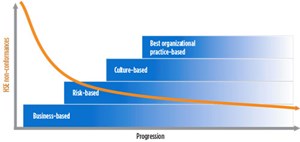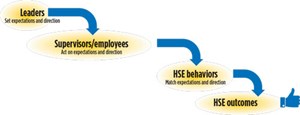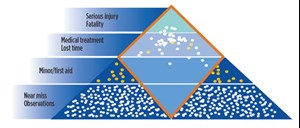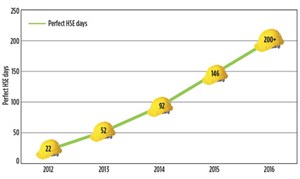Organizational change can be achieved through HSE leadership
Although the industry has improved health, safety and environmental (HSE) performance over the last several years, a renewed focus on safety-critical systems is required to prevent damaging HSE incidents and reduce the risk of major disasters. For significant change to occur, it requires proper alinement of technology systems and an unwavering commitment from organizational leaders, who set behavioral expectations and a company’s direction.
CHANGING HSE CULTURE
Our own company’s journey to organizational change through HSE management began in 2009, after the consolidation of various product- and service-based companies into a single corporate entity. The process was intended to redefine the company, and how it did business, by weaving HSE into the fabric of the new organization through its purpose: enabling safe, affordable energy and improving people’s lives. Three critical success factors were identified:
- A strong business framework
- HSE culture roadmap
- Leadership engagement.

Strong business framework. A pragmatic business framework was outlined, to drive nonconformance out of the system and ensure a lasting culture change, Fig 1. The plan contains four pillars: 1) All activities and HSE programs must be aligned to support the business; 2) Place focus on hazards intrinsic to the company’s business and product lines; 3) Ensure that the “HSE conscience” would be believed from within the organization, beginning at the very top level; 4) Base the framework for change on learning from others, then applying their best practices.
HSE culture roadmap. According to a 2016 report by the U.S. National Academy of Sciences, an organization’s culture reflects the shared, tacit assumptions that have come to be taken for granted, and which determine an individual’s daily behavior. The U.S. Nuclear Regulatory Commission defines safety culture as the core values and behaviors, resulting from a collective commitment by leaders and individuals to emphasize safety over competing goals, to ensure protection of people and the environment.
Andrew Hopkins, emeritus professor of sociology at the Australian National University and noted author on energy sociology and risk, declared that a company may expend extensive resources trying to change the way operatives and supervisory staff think about safety, but a far more effective approach is to instill a philosophy of, “This is the way we do things around here.” This approach, weaving HSE into an organization’s DNA, was the desired goal for Baker Hughes.

To initiate the process, our organization adopted a roadmap to define and describe the journey to a mature safety culture. The company built its own version, based on a model developed by Patrick Hudson, in addition to the DuPont Bradley Curve, Fig. 2. The roadmap has three main phases, starting in a dependent phase, then moving through an independent term, before culminating in an interdependent safety culture, where zero HSE incidents are an expectation.
In the dependent phase, HSE is driven primarily through use of control, discipline, rules and regulations. As the culture matures, it moves into the independent phase, in which employees begin to take personal responsibility for safety, rather than just relying on rules and regulations to create a safe work environment. The next phase in the journey is the interdependent phase, in which a “peer’s keeper” approach to HSE is adopted. In this phase, employees don’t just look out for their own safety, they also consider the safety of other employees. At this stage, management works collaboratively with employees on HSE matters, feeling comfortable leading or allowing others to lead.
The interdependency phase is established and sustained by achieving operational ownership of HSE by employees assuming accountability for performance and maintaining a safe work environment. This ownership is characterized by employees intervening in unsafe acts and conditions, while engaging with the HSE function to identify and implement risk-mitigating controls and processes. This leads to a collaborative engagement with HSE, rather than management acting as a police force within the organization. While operational ownership leads to all employees assuming accountability for HSE performance, it is essential that senior leadership be a driving force to embed this concept throughout every level of the organization. Only when upper and middle managers adopt this HSE philosophy, will the rest of the organization follow.
Leadership engagement program. The recognition of the importance of the role of leadership in building and sustaining safety culture is evident in the first of the Bureau of Safety and Environmental Enforcement’s (BSEE) nine elements of a strong safety culture. This element says, “Leaders demonstrate a commitment to safety and environmental stewardship in their decisions and behaviors. Leaders visibly demonstrate this commitment through how they allocate resources within the organization and prioritize safety, relative to production.”
Five additional BSEE elements are: 1) a respectful work environment; 2) an environment for raising concerns; 3) effective safety and environmental communication; 4) personal accountability; and 5) an inquiring attitude.

To accelerate the establishment of a strong HSE culture across the Baker Hughes organization, it was decided to create an HSE leadership academy, directed at senior and middle managers. The academy was founded on research findings that indicate, as leaders set expectations and direction for change in an organization, they can shape the behaviors of their supervisors and employees. The goal of the HSE leadership program was to increase senior managers’ operational ownership of HSE, and provide a “line of sight” as to what effective HSE leadership is and how to apply it to the respective daily activities. The goal was to help leaders understand that focusing on behaviors is more effective than concentrating on outcomes, and that this would accelerate a culture change. If upper management set the proper expectations, they would likely get the desired outcomes, Fig. 3.
Aligning HSE with business priorities. Considering that safety in an organization competes with other priorities, such as profitability and productivity, it became clear how important it is for senior managers to keep HSE on par with other business priorities. Some unsafe behaviors can become self-reinforcing, if leaders don’t continually emphasize the importance of HSE. For example, if a procedural shortcut or using an incorrect tool saves time and doesn’t result in injury, the positive consequence of the unsafe behavior essentially reinforces it, unless leaders remain resolute in supporting their safety managers through specific communications and motivational actions.
Rather than use an HSE consultant and adopt that person’s terminology, the company built the academy, using examples from our own incident experience to educate leaders, managers and supervisors to the roles they play in causing and/or preventing incidents. The academy members shifted their focus and sense of responsibility away from employees onto themselves.
For the HSE leadership academy program to succeed, it also required the same level of commitment from management outside the HSE function. If this commitment is not present, participants will neither recognize the importance of the training nor fully commit to its lessons and practical application. To address these issues, a series of overviews was conducted to gain leadership’s full buy-in. After the training, upper management communicated to participants the importance of the program, and their commitment expectations. The leadership teams also were present at the beginning of the classroom-based portion of the program, to make opening comments and reinforce that the training is integral to the business.
Modeling good HSE behavior. Each concept that was taught was designed to demonstrate good HSE behavior, so that participants could apply the concepts to their job functions. The academy was based on the antecedent-behavior-consequence (ABC) model, a methodology grounded in empirical research spanning more than 50 years. It is made up of three components: 1) antecedents or events that trigger behavior; 2) behaviors that are observable acts; and 3) consequences or events that follow behavior.
The ABC model enables managers to identify and describe good HSE behavior. It replaces vague statements and attitudes toward HSE with more observable, behavioral terms such as, “I want all my reports to review risk assessments before the start of a task.” These concrete statements enable managers to be more direct in their HSE leadership. The model also helps managers understand how their own actions affect the HSE behaviors of others.
By applying the ABC model and setting timely, certain and positive consequences for safe behaviors, the manager can counteract the positive consequence of an unsafe behavior. This gives an employee the incentive to choose a safe behavior over an unsafe behavior.
COMPLEMENTARY TRAINING
After the two-day classroom training was completed, instructors followed up with remote coaching for an extended period of time to promote retention and use of the learned HSE leadership characteristics. The remote training process ensured that participants could be coached remotely, regardless of their geographical location or time-work schedule.

The structured coaching concentrated on written, one-on-one e-mail diaries sent biweekly by the participants to their coaches for three months following the classroom training. The written journal concept was chosen to facilitate self-reflection of the participants’ individual performance for HSE leadership. It was believed that the writing process would create visibility of these behaviors, and assist in the self-assessment process. Coaches encouraged reflection on what HSE leadership opportunities were missed, and planned a path forward to identify opportunities in the forthcoming two-week period.
To further address program sustainability, the coaches encouraged the leaders to organize supplemental events, including HSE meetings, town hall gatherings, and performance reviews with informal HSE leadership behaviors and other naturally occurring conversations. These casual communications are more likely to demonstrate authenticity by the manager.
Evaluating remote coaching effectiveness. The results demonstrated that the process was effective at the individual participant and coach-participant level, but most importantly, it facilitated actual learning and knowledge retention. Results showed that employees’ perceptions of their managers’ HSE leadership improved, and this positively impacted their own HSE behaviors. The results demonstrated that the program was changing behaviors within the organization and had a direct impact on the operational ownership of HSE.
For Baker Hughes, the combination of a strong business framework, an HSE culture roadmap, and leadership training dramatically accelerated the evolution of the HSE culture from dependent/reactive to interdependent/proactive, and now generative/interdependent. This focused initiative generated a transformative shift that produced the company’s “Perfect HSE Day,” a day with no injuries, no accidents, and no spills. It has fostered additional steps that have closed performance gaps and identified a significant number of behaviors that led to incidents, Fig. 4. Identifying these areas for HSE improvement, both technical and organizational, creates a stronger sense of urgency, and leads to better intervention strategies and more effective risk management programs.
SIGNIFICANT HSE IMPROVEMENT
For the company’s leadership team, the Perfect HSE Day has meant engaging at an entirely new level of ownership. All executives have become more visible, and they share their HSE views publicly. We now have meaningful HSE conversations with all levels of employees. And, management not only supports, but publicly recognizes, employees who stop work when continuing would pose a threat of injury, accident or spill. All of these efforts have contributed to an important HSE culture shift that has made the company a safer place to work. In 2015, the company’s number of Perfect HSE Days reached 146, with a projection of over 200 perfect days in 2016, Fig. 5.
However, the most important aspect of the new culture is that “zero-thinking” HSE is integrally woven into the company’s DNA, to effectively manage risk throughout the entire organization. ![]()



